The Magickal Philosophy of Templum Babalonis
Book II - Principia
The Philosophy of Ophidian Thelema
Also known as: The Principles

Chapter 1 - The Manifestation of the Divine Serpent
Persona and Spirit
"Be it ever nearer to the future, that this Temple shall hold the space of another.
And you shall go forth to bestow your world in anew. Clutch not at the ash, but
at the snake of light."

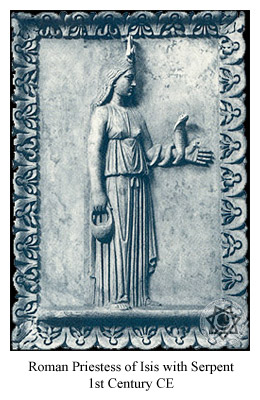 It
is no accident that the whole of the recorded spiritual history of mankind, in all
of its myriad forms and manifestations, is rife with images of serpents and snakes.
We find them on the pillars of those most ancient Temples at Gobekli Tepe. We find
them on the household walls in Rome, in the myths of the Hebrew Garden of Eden,
and as the poisonous serpent
Satan in the religion of Christianity. Across the ancient world we find snakes biting their own tails, winged serpents guarding doorways, coiled serpents on heads, on brows, or imagined in spines
as Kundalini energy. From the Near East to India and China, from Hinduism to Buddhism
they appear at the pinnacles of the myths and religions of those cultures. And,
closer to our own hearts we find images of ancient Priestesses from Greece and Crete and Egypt, holding serpents in ritual poses as if seeking to convey something
of import concerning their station. The image of the serpent has remained ubiquitous throughout recorded human
history, and yet no one today seems to understand why this might be, or what it
might mean.
Some conjecture that the original Pagan image of the serpent represented wisdom, or immortality, or cunning insight,
or a power of some sort, be it spiritual or temporal. This image of the serpent seems to shift and change, depending upon which era
and which culture one is looking at. In contrast to the Pagan images of the serpent, the Hebrew followers of Yahweh, and their spiritual
heirs in Christianity and Islam, would see in the serpent a tempter to something forbidden and evil. They see
a poisonous and slimy creature that slithers through the dark, oozing venom at the
sight of naked female flesh. For them the
serpent seems to be an image of the phallus itself, distorted by their own
wretchedness and self-loathing.
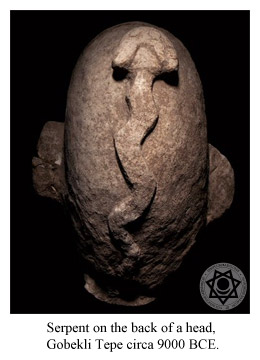 Therefore,
in order to navigate the varied images of the serpent in so many different times and places and discover
any purpose or meaning, one ought to first return to the origins of the serpent in history. One can find such an origin with the
Neolithic Goddess worshippers in the pre-history of our species. They were the original
Ophidians, and they possess
the original Lineage of the Serpent
Cults. And since, unknown to most, their Lineage extends even to this day it seems
fitting therefore that it shall be the
Ophidians themselves who shall reveal this Mystery of the Serpent. And as we shall show, with this Mystery comes
many cultural reactions which echo down through the epochs of history, shaping the
historical events of spirituality even to this present day.
Originally the serpent was
primarily the image of a person’s divine and immortal Spirit, but it could also be seen to signify any kind of
spirit in a general sense.
The reason for this was the belief that
serpents came up from the Underworld,
which was a mysterious place presided over by the Goddess deep within the Earth.
In those days the Goddess alone ruled Sky and Earth and Underworld. It was in this place of the Underworld that souls,
spirits and shades
resided. Not only did the serpent
seem to dwell in the Underworld,
but it was also thought that serpents,
like spirits, were very long
lived, if not in fact immortal. It was thought that instead of growing old and dying,
they shed their old skin. The serpents
were thereby periodically reborn with slick new skin and extended life. It seemed
to the ancients as though serpents
and snakes had magical powers
of regeneration. In addition to their powers of regeneration, the pupils of their
eyes were vertical slits which gave rise to the belief that they, like cats, could
see into the otherworldly places of the
spirits. To the Ancients, snakes
were denizens of the land of spirits
and undying creatures of the Underworld
with special powers. They were true messengers from the Underworld.
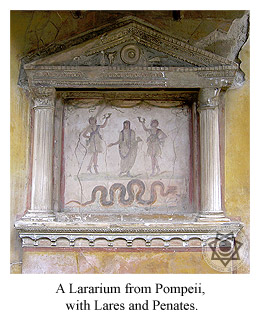 So
it is no surprise now that we find
serpents on the walls of the most ancient temples, since they are places
for spirit in all its forms
to manifest. On the household walls of Roman families we find the Lararium, which
depicted the guardian spirits
of the family. A snake would
often appear under the central Lar, the founding ancestor of the family. This snake here first represents
the continuous line of ancestor shades
in the family going back to the original ancestor, who is pictured as the central
Lar. Secondly it is the living genius
of the family bloodline itself, personified as a spirit. In other examples, one finds the Ouroboros, or snake biting its own tail. This was simply an image of
the eternal birth, death and rebirth of the
Spirit in manifest bodies. Of more importance to the Ophidians is the image of the Priestess holding a
serpent, which shows that she is a liminal gateway for spirits, as shall be explained in more detail
in later chapters. In many instances throughout history the Ophidians do not anthropomorphize their Goddess, the Great Liberating Mother who has gone under many, many
names. Rather, we prefer to instead show an image of a serpent or Cobra
alone, or a Priestess holding
serpents.
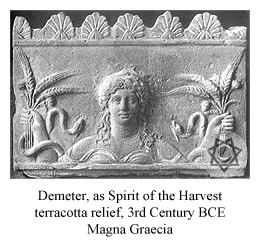
In contrast to these positive views of the
serpent the monotheistic god of the Jews demanded that he alone should possess
completely the souls of his worshippers upon death, and that they should give him
complete spiritual obedience. Therefore it is little wonder that the image of one’s
eternal Spirit as a snake should be vilified as a temptation away from the will
of Yahweh himself. For one’s Spirit
is autonomous and inviolable, transforming itself in each incarnation like a serpent shedding its skin. Yet here the serpent was purposely distorted by the monotheists to
frighten people away from the Great Liberating
Mother and Her symbols and images. And it is interesting to note that despite
the proclivities of modern psychology, the
Serpent was originally a female symbol, not an image of the phallus as it
later became in monotheistic times. This switch from female to male in imagery was
originally accomplished by the early Christian spermo-gnostics, and has been reinforced
by a modern understanding of sperm which some see as serpent-like in form, but which
is actually more tadpole-like.
One could go on with these examples of
serpent symbolism almost endlessly, such is their number in history. So
let it be understood in general that when you find snakes in the ancient Temples, not just pictured on the walls
and in prominent places, but actual
serpents with actual Priestesses
attending to them, then you have found us in history, the Ophidians. And often the
snake we use is the Cobra
for many reasons, not the least of which is the fact that this snake carries on the back of its hood the mark of our Great Mother Nuit. Or as Babalon says, " Hadit
is a manifestation of the Will to Spiritual Advancement. The Sun rising on wings.
Or the Winged Serpent, like
you say. That’s why the serpent
bears the mark of my Mother."
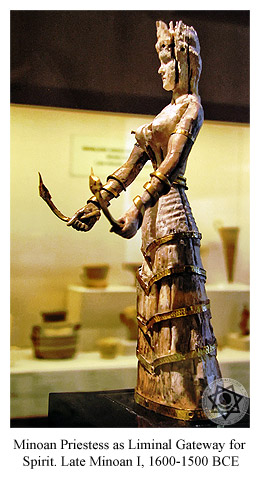
Now it should be understood that the
serpent is the image of the Spirit.
And furthermore it should be understood that there can be no life on this planet
without Spirit manifesting
in matter. This fact used to be self-evident, until very recently in history. Spirit animates, in every
sense of the word. Spirit is
the Prime Mover. All things which live and move do so because they are literally
possessed by a spirit. Without
Spirit there would be no life
anywhere in the universe. In fact, there would be no thing at all, either animate
or "inanimate". Spirit is the
supreme source of Light and Life.
So therefore it should be no surprise that the
Mother of all mothers, the Mother
of all Life on this planet and throughout the entire universe, the one
whom we today call Nuit – it
is no surprise that she bears this light of
Spirit into existence. And this light of
Spirit is forever renewed and changing, and never diminishes. Every
living thing, no matter how motionless or how small, possesses spirit energy. The planet itself, which is a living being
called Gaia by some, the little
sister of Our Lady Nuit, imbues
even the otherwise lifeless matter with Her
Spirit, and makes all life possible here. Without Her Spirit powering life on this planet, there would be nothing
but an inanimate shell.
Each person that is born here within the body of Gaia possesses a unique
Spirit of their own. This Spirit
is sometimes called your True Self, Divine Self or Divine Spirit and is always capitalized in order to differentiate
it from other types of spirits,
such as shades, elementals,
angels or demons, to name a few. This
Spirit is one’s immortal, divine, unique, higher self which incarnates into
flesh in order to achieve its great and terrible purpose, which we call its Will. It is immortal in that it is deathless, and imperishable
like all spirit is. It is divine
in that it is incorruptible and perfect in its nature and possesses a consciousness
with a much greater horizon of awareness than your own manifest self. It is unique
in that it is like no other Spirit
in its nature and consciousness, yet it is always recognizable in every incarnation
no matter which different physical body it is born into. It is one’s higher self
in that it creates and informs all that one is, and without which one would certainly
cease.
On a personal level, the Will
of one’s Spirit is felt to
be the guiding sovereign purpose in life, and one’s reason for incarnation. All
Ophidians are here for a
purpose, and there is no greater and nobler act than accomplishing the purpose of
one’s incarnation, or to die trying to achieve it. This is the meaning of the phrase
"Do what thou wilt shall be the whole of the law." It is a commandment to achieve
one’s divine purpose, above which there is no other.
Concerning your Will it is also
important to note that no other person, no matter how advanced or well-meaning,
is able to tell you what your Will
is. It is expressly a matter between your
Persona and your Spirit.
Most often your Will changes
from one lifetime to another, but often there will be overriding themes which will
be of a similar nature throughout many lifetimes.

It should be mentioned here that the Templum Babalonis only teaches two subjects to its students,
and these are the same two subjects which certain spirits themselves have taught to humanity throughout time:
Heka and Natura. These two philosophies contain Principles and Rituals
which are inextricably interwoven, for one greatly affects the other. And by these
two things, all other things in life and in death are made known.
Heka is the Ancient Egyptian
word for Magick, literally
meaning the activation (He) of the vital essence of the Spirit ( Ka).
Therefore Magick is the act
of calling down the Spirit
into the body, so that its consciousness, awareness and powers predominate. But
for this to take place, the Persona
(see below) must be fashioned into a proper vehicle for the manifestation of its
Spirit. The Principles for
doing this are called Natura.
It is in Natura that we find
the secrets of the body, its energy pathways, how the substances we ingest affect
not only our health, but also our emotions, our consciousness and our ability to
manifest Heka. We discover here
the importance of how we walk upon this planet, which is a living being, and from
whom we draw our sustenance and substance. This notion of mindfulness in our daily
actions towards Gaia, the World Soul, is not some vague philosophical or romantic idea
of "oneness with nature". Rather, how we interact with the natural world in every-day
life has a very deep impact upon which
spirits we are able to interact with in our Magick, our Heka.
And this fact is something that very few people realize. Even fewer understand the
implications and limitations of this fact upon their Heka. With the Principles of Natura one finds the Keys for unlocking the power of
Heka. And the further one pursues
Heka, the more one discovers
the Principles of Natura, which
makes its manifestation possible.

Now as we have said, the Spirit
incarnates in a physical body which is manifestly alive by virtue of its presence.
However, this physical body has its own consciousness and sense of self separate
from that of the Spirit. We
call this physical body and its separate consciousness "the Persona". And it is this " Persona"
which is the focus of Initiation
within the Temple. However, the Persona's
first purpose is to be responsible for the well-being of the body and to help navigate
the physical world. To this end it potentially has a great awareness on many levels
of being, and a great many interfaces with the physical world and the world of spirit. Yet very few people
have any awareness at all beyond the base functions of the Persona, and its limited focus based upon its immediate needs
and desires.
The Persona then is the basic
body and personality of the individual, with all of its memories and experiences
of its life. With this in mind, let us show how the Persona operates on four basic levels of awareness, which
follow the four traditional Elements of the Ancients. It is important to note that
it is in this way alone that the Persona
is wed to the Spirit. These
Elements not only describe the way in which the Spirit indwells the body, but also the origin and evolution
of life itself as it reaches back towards
spirit through the historical and evolutionary record.
To start with, the most basic level of awareness possible is that of the body and
its senses of touch, taste, smell, sight and hearing. It is these bodily sensations
that are associated with the Element of Earth. Earth is all things physical, all
things dense and all things sensory. In Earth are all of the biological processes
and reactions, and all of the bodily functions which depend upon the senses.
But in addition to the obvious physical sensations perceived by the senses, the
body can also sense energy changes caused by spiritual forces. It does this in a
way which overlays the normal sensory apparatus. For example, a Spirit may cause a person to feel a cold sensation moving
behind them, or prickly warm energy in their hand. The person hasn’t really encountered
anything in the physical that has caused these sensations. The body, however, can
sense the spirit's presence
and energy and is relating these sensations to the brain through the senses in much
the same way that it would with physical sensations. One’s body holds your own Spirit, and therefore it can
sense others as well.
In addition to being the gateway of sensations, the Earth layer of the Persona houses in its body all of the behavioral reactionary
complexes of the Persona.
These are the involuntary responses to stimuli, like pulling your hand back from
fire without thinking, or the act of breathing. The behavioral reactionary complex
also includes all of the instinctual behaviors of our animal selves, and our ability
to navigate the world by these behaviors. In addition to instinctual and involuntary
behaviors, the Earth layer of the
Persona includes patterns of behavior. Examples of this include physical
routines which make one feel comfortable like relaxing in the same chair after a
long day of work, or reaching for your tooth brush in the same spot every day without
thinking about what you are doing.
It is interesting to note that these behavioral responses are more "you" than you
probably realize, and account for more of your decision making process than the
mind would probably believe. Because of this, the unraveling and understanding of
your own behavioral reactionary complex becomes so terribly important in the Initiatory
process. One of the great virtues of the use of ritual in one’s life is to set up
new behavioral processes that are superior to your previous behaviors and habits.
This has a profound effect on one’s
Persona, and its relation to Heka.
A great deal of attention is paid to this process of ritualized behavior changes
in the Temple, so much so that the whole of the next book is completely devoted
to it, under the heading of Natura.
Sitting on top of the behavioral reactionary complexes of Earth in the body are
the emotional reactionary responses of the Waters. It is here where the Persona feels the meaning or importance of the information
provided by the sensations of the body. This is a very important point to understand.
This meaning comes in the form of emotional responses which are felt in the body
as an emotional state or feeling. Like the behavior reactionary complex of Earth,
the emotions and moods of the Waters also affect our decision making processes much
more than we realize. One often thinks that one is making a rational decision with
one’s mind based upon facts and logic, when in actuality one is often reacting to
an emotional or behavioral response which "feels right", and is therefore interpreted
as "logical".
And so we come to the Filas.
For it is here in the Waters that Filas
are created, which are so important to magical processes and energies - so much
so that they are no longer even spoken of in this corrupt and degenerate age. Filas will be discussed at length
in the appropriate place, but suffice it to say for now that a Fila, literally a cord or string, is an emotional and experiential
connection to something (an event, person,
spirit, energy, etc.). But unlike a simple memory of something, a Fila is a direct connection or magical link to the thing,
created by an experiential imprintation of spiritual energy acting upon the body
and the emotions of the individual. The
spirit energy literally makes an impression in the Earth and Waters of the
Persona. And the virtue, or
the curse, of a Fila is that
is can be called up again or summoned back into existence, at any given time or
place. Once a spirit of any
sort, or any type of spirit
energy, is in your presence it creates a
Fila, to a greater or lesser extent, which has an accompanying "feeling".
This Fila can be used to call
the Spirit back to manifestation
again. This is accomplished simply by returning to that place in the Waters of the
Persona where the imprintation
occurred. Filas are navigated
to in the Waters of the Persona
by feelings, directed by magical ritual ( Heka).
These are not the common, dramatic feelings of the Persona, but rather impressions left upon the place of common
feelings by spirit energy of
one sort or another. In the same way that the senses of the body can be made on
rare occasions to "feel" spirit
energy, so too can the emotions and feelings of the Waters be used in a similar
fashion. This process is, in fact, more common than the former, but no less confusing
for the uninitiated, for in fact the
spirit energy itself is affecting the places in one’s Persona which causes emotional reactions, and it can
be difficult to understand at first which feelings are from your Persona, and which are not. Modern so-called "occultism"
is rife with such confusions. In fact, we would say that "occultism" is more a system
based upon those confusions, than it is based upon any understanding of Spirit.
But, to return to Filas, let
us consider for the sake of example a common reaction to an encounter with what
is commonly called a ghost, but which we call a Shade (which is simply the Persona of a dead person, left in the realm of Earth).
Often this experience leaves quite an impression upon the Persona, in a manner which is difficult to convey to another
person. There may have been a feeling of anxiety, coupled with exhilaration or fear.
There most often will have been a bodily reaction, the quickening of heart rate
and pulse, the distortion of time, increased alertness, or even panic, or an endless
host of other symptoms. All of this, combined with the actual encounter with the
Shade's energy in time and space
create an impression, very literally, upon the Persona. This is the creation of a Fila.
Then, at a later time, when a person recalls the experience of the encounter and
perhaps when one is attempting to tell others of their experience, they will start
to feel the terror or horror or excitement of the encounter all over again. Sometimes
it may even feel as though the Shade
is actually in their presence again. Often those who are being told the story can
also feel the presence of the Shade
as well, and the hair may stand up on their arms or neck. This transference of spiritual
energy through the Waters of the Persona
is a Fila, and in the hands of
an Initiate one could potentially
call the Shade to appear again.
But one should also be warned that Filas
can work in both directions, with the pull emanating from the other end as well,
which is why demons, once called, can wreak so much havoc and trouble, regardless
of modern banishing rituals and the like. In a magical sense, Filas are somewhat similar to String Theory in Quantum
Physics, which is nothing more than a poor scientific way of understanding an Ancient
Principle. They, of course, have despiritualized the concept to the point of uselessness.
Now, if you have been living by the Principles of Natura, your Persona
should have the largest and strongest
Fila of all to your Spirit.
Your Spirit should have the
strongest presence in your Waters, out of all possible influences there. Unfortunately
this is rarely the case, and so therefore much of magical Initiation is inclined towards making that aspiration a reality.
This is an important endeavor, for one’s
Spirit can only communicate with the conscious mind of the Persona in the waking state through either the Persona's Fires, or the
Persona's Waters.
Part of the training of the Temple is to help an Initiate identify the source of their feelings in their Waters,
and to thereby understand who or what is causing that feeling in the Waters of the
Persona. We call this the
whole process of the Waters and the way in which they work the Emotional Language. This Emotional Language is a personal language of Heka, long forgotten and lost by the modern world,
which denigrates and despises the Waters as a source of weakness. Because of this,
most modern people are like children who have never been taught to understand the
complexity and sources of their feelings. They often assume their feelings are all
their own, because after all it is they themselves who are feeling them. Nothing
could be further from the truth, for communications in the Waters can come from
not only their own Persona,
but sometimes from some Fila
(and hence from some outside influence), or from your Spirit. The emotional reactionary complex of the Waters can
have many sources of input, very few of which are understood in the modern era.
To this end the temple teaches of the Waters differently than methods currently
used in the modern era, which are usually psychological in nature, ranging from
structured psychology theories of academic mentalism to the "hippy" and "new-age"
exploration of emotions at an almost childish and rebellious expressive level. The
Ophidians teach a ritual
exploration of the Waters, introducing the Language one finds there, so that the
student may first discern which communications are coming from their Persona and its experiences in life, versus which currents
come from the Spirit. The latter
are rare at first, and are most often felt as intuitions in mundane people, but
grow in concert with the power of the
Spirit in an individual.
Once fully developed, the powers of the Waters are second to none in Heka, which is why they feature so prominently in the old
creation myths of most cultures. Within the currents and eddies of the Waters an
Adept can easily sense meaning
within spiritual energy, which functions somewhat like a higher form of intuition,
but which is nothing of the sort. One also develops a new vision which can detect
the presence of spiritual entities, which in reality are more abundant than most
would believe. Once developed, the Waters are also excellent at discovering subterfuge
or strange intentions in other people and their agendas. One learns this by using
the Ophidian training and
rituals which help to teach one to sense the uneasiness that the presence of others
can sometimes cause in your Waters, and how to properly interpret those feelings.

Now the compliment to the Waters of the
Persona are its Fires. The Fires contain all of the drives and desires of
the Persona, as well as all
of its vitality and strength. Like the Waters and its Emotional Language, the Fires have their own form of expression,
and it is the Language of the Passions. The Fires can even manifest as the Presence
and Power of the Spirit itself,
as it seeks to guide and drive the 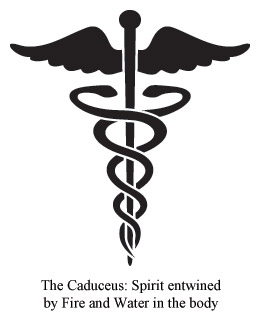 Persona
Persona to do its Will.
But of course not all passions and desire originate in the spirit, and again like the Waters, the Fires too can be influenced
by Filas, amongst other things.
Therefore, all drives and desires of the
Initiate, no matter how out of the ordinary, must be studied and pursued
so that the origins of the desire be uncovered. Often this can not be done without
fulfilling the desire itself, and to undergo the experiential changes subsequent
to that accomplishment. This is very important, as intellectual wondering or fantasizing
will not achieve the same result. Only in experiential hindsight will the motivation
for a desire become clear. But the point remains that one can better know one’s
Will by knowing one’s true desires
that originate from the Spirit.
And the action of fulfilling all those drives and desires will set you upon the
Path of the Spirit, so that
you may fulfill its Will.
It should also be noted that sexuality and its attendant Language of the Passions
is one of the foremost ways in which the
Spirit seeks to communicate with the
Persona. But because of this, and the jealousy and fear engendered within
it by the monotheists, it is also one of the most suppressed and misunderstood of
spiritual behaviors. For it is a true Principle that if you can unlock one’s sexuality,
then you will unlock one’s Spirit.
In this way it is certainly possible for
Spirit to enter close during certain sexual acts. But of course if done
in an improper manner, other spirits
may enter in. There are many pitfalls therein, and the Priestesses are specially trained in the Inner Temple to guide
Initiates through these tremulous levels of spiritual sexuality.
For debauchery is a real and present danger for the Initiate, and to this end the Priestesses teach the
Balanced Ecstatic Path. Concerning what more we can say of this
subject will be said in its proper place.
The presence of one’s Spirit
in the body causes its Fires to glow hot. This is often accompanied by the magical
powers which appear when the Spirit
is close in the flesh, such as the unmistakable gleem in the eyes, the expansion
of the presence of the person which affects the Waters of all those around them,
and the fascination which the Spirit
in the Fires can hold over those nearby. It affects the voice and the power of the
voice, and almost always grants what
Babalon calls the Pia Mezza,
the Liminal Vision. It is a middle-way between worlds, which can cause one’s vision
to have strange overlays of shapes and colors, and is a harbinger of spirit ingressing into your presence. In addition, this almost
always takes place before the physical manifestation of a spirit.
It is the Fires themselves which power the
Heka of the Priestess
or Magician, and they are stoked and fostered to be the main driving force in rituals.
Properly managed and trained, the Fires will carry one through the darkest of Initiations and the most
dismal of times, by the Light of the
Spirit burning in the heart.
Now it can be seen that the throne of the
Spirit is the earthly body with its senses and behavior reactions. Sitting
directly upon the behavior reactionary complex of the body is the emotional reactionary
complex of the Waters, which gives meaning to experiences and contains your Filas. The way in which your Spirit communicates to you in the Waters is the Emotional Language. On the opposite side of the Waters
are the drives and desires of the Fires. This is also the source of your vitality
and strength, and is how the Spirit
drives you to your purpose and manifests itself. In the center of all of this, with
the Earth below, the Water on the left and the Fire on the right is the Air – the
place of the mind.
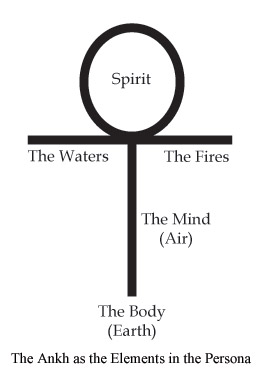

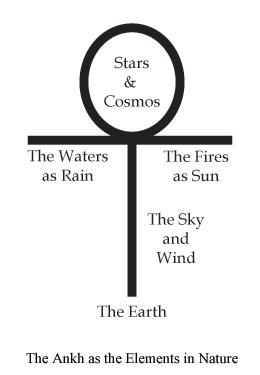
The mind is first and foremost the center of awareness for the Persona. Its purpose is to manage and store sensory information,
facilitate physical navigation of the environment, manage the appetites, and use
its logic and intelligence to help the
Persona survive. It must be thoroughly understood here that the mind is
separate from the Spirit, and
in no way does the Spirit partake
of mind, nor is it similar to mind in any way, other than they both possess a type
of consciousness. This is contrary to most modern teachings, which confuse the mind
as Spirit, and the mind as
the source or cause of Heka or
Magick. Spirit can not directly communicate to the consciousness
of the mind. It can only do so through the conduits of the Fires and the Waters,
or more rarely through the bodily sensations and dreams. The Mind, or
Air, can not communicate directly with
spirit in any form, which is why it is easy for mind-centered people to
"disbelieve" in the existence of anything outside of the mind, and their bodies.
Atheism is simply a disconnect of the
Persona and the Spirit,
which is easy to accomplish by living in the modern ways in which most people do.
It will simply happen unbidden.
This is also why it is said that " spirits
traverse the Air," because it is a place they must cross in order to make their
presence known to the individual.
The Air is the place of your mundane mental faculties of logic (both linear and
associative), memory, and reason, none of which is your true consciousness or true
awareness. The source or origin of true consciousness is the Spirit. All life is manifest because of spirit, and this manifestation is evident through the
appearance of consciousness in the creature. Even plants possess consciousness,
albeit on a much more limited scale of awareness. The Air of mind is the focal point,
the convex, the crossroads of reactionary behaviors, memories, experiences and spiritual
influence. The mind has direct access to memories in the brain, which were imprinted
there by emotional reactions to experiences. This shows us the Watery origin of
memories.
It is important to understand that one's mind has its own sense of self, its own
sense of being, and possesses its own agenda separate from that of the Spirit. It collects impressions and feelings from the bodily
senses, the emotions and the passions, in order to pursue its own agenda. This agenda
of the mind is originally one concerned 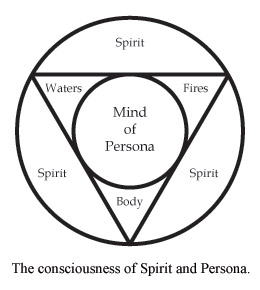
mainly with fulfilling appetites and maintaining survival, which gives the Persona a sense of pleasure and satisfaction. Out of these
appetites and survival responses come the whole host of human behaviors, all modified,
warped and changed by the experiences and imprintations of the Persona, in myriads of different ways.
At this point it might become clear to the reader that the desire of the Persona and the Will
of the Spirit are not one in
the same thing. And this fact is indeed the prime source of spiritual conflict in
humanity. In fact, one of the greatest purposes of Initiation is to align the desire of the Persona to the Will
of its Spirit. This is no small
feat, and by doing so it aligns the
Persona to something greater than itself and its mundane agenda of appetite
fulfillment and survival.
For it soon becomes apparent that Air is also War. It is both a medium and a conduit,
and the most dangerous place of all. It is the War to survive, with its attendant
will to Power. Air is the conflict of appetites, each vying for supremacy and control
of the body at various times. And the Mind is the place of contention between Persona and Spirit for the destiny of the individual incarnation.
One can now see clearly the whole sorry history of exoteric spirituality throughout
the ages, revolving around the agenda of the
Persona in conflict with that of the
Spirit. In fact, the point of most common failure for the Persona, as the
Spirit seeks to subject it to its
Will, is that of the fear of death. The survival instinct
is the strongest instinct of the body, and rightly so. Yet this instinct does a
great disservice to the Persona
in a spiritual sense. The Persona
is mortal, yet seeks to never die. The
Spirit is deathless, and seeks to bend the Persona to its Will
in order to fulfill the purpose of its incarnation. This conflict, which is often
more acute in men than women, is the crisis which creates the Abyss.
And the greater the gulf is between the
Persona and the Spirit,
the greater the Gulf of the Abyss
will be.
There is often a slow building of this crisis in the Initiate over the course of their magical career, which at
some point culminates in a full-blown crisis of control. The conflict is over the
destiny of the Persona, and
who will decide it. In this dangerous place the Persona, driven by its profound survival instinct which manifests
as a fear of death and mortality, often makes a gambit for immortality, seeking
to attach itself to the Spirit
and usurp its throne, or to strike some bargain so that it will never die. There
are many religions which offer promises and solutions for this crisis, all of which
fail. And there are many demons that lay in wait for this very moment on the Initiates path. These demons speak the language of the mind,
of Air, and are masters of rationalizing their desires in ways which seem logical
and proper. When they speak, it sounds no different than the voice of the mind,
such is their skill at cloaking. This is one of the reasons why it is said that
demons are of the Air, and that the Air contains the Abyss.
The Priestesses of Templum Babalonis in
Ophidia are well trained in the ancient ways of dealing with this problem
of Air. These ways are the secret female ways of the old Goddess culture, now lost
to the memory of man. They are the Silent Ways of the Night. There is no verbal
teaching here, no words, no lectures and no books. For it should be realized by
now that the mind of the Persona
should never be the leader and originator of ones destiny, but only the facilitator
of something greater than itself. One can stir a person into rebellion against their
Spirit with knowledge, but
never with wisdom. For knowledge is born from the mind, but wisdom is born from
the Spirit. This is why in
many ancient cultures the serpent
was synonymous with wisdom, for the
Spirit brings wisdom to the Initiate
which works like a memory. This wisdom is a true understanding of things in ways
that the Persona can not achieve
on its own, and which is not the result of logic or rational thinking.
If there is to be success in the pursuit of
Heka for the Initiate,
then there can be no distraction for the mind of the Initiate in this endeavor. It must be liberated of its desire
for any purpose other than fulfillment of the
Spirit's Will. This can
not be accomplished by the Initiate
who is trapped in the modern world as a wage slave, concerned with money and jobs.
One simply will not get very far with
Heka, as one’s Persona
will have competing interests. One’s
Persona is endlessly bombarded with the distractions fostered upon it by
the commercial and industrial pressures of media, entertainment and social stratification.
The demands for attention and obedience by corporations, governments, technology
and society will never allow the Spirit
to ascend to its rightful place of predominance in their midst. In fact, the body
itself is under attack by unhealthy, toxic and genetically modified foods and chemicals
never meant for ingestion. These substances, along with the packages they are housed
in which leach very harmful chemicals into the food they contain, all cause a great
dis-ease in the body, on the physical and chemical levels. Additives in the water,
specifically fluoride in many localities, have a very adverse affect on pineal gland
activity, which is the seat of the Will
in the biological human, and one of the great gateways in which the Spirit communicates to the Persona. If this gateway is damaged, then there is very
little chance the Persona
will have the will to undergo the
Initiation and discipline required to achieve meaningful results in their
training, and will simply never feel much of a connection to anything even vaguely
"spiritual". This certainly describes most individuals of this day, who wander untethered
to any real sense of identity beyond fulfillment of their addicted appetites and
inflated egos as spoiled children of the consumerist empire.
This is why it is required by the Temple for those who seek out the mysteries of
Heka to physically relocate to
Ophidia, our sacred "monastery"
deep within a natural setting, so that the body and mind can be detoxified, repaired,
and the distractions of civilization removed. But that is not all, for the Genius of Ophidia
lends its powers to those that dedicate themselves to the Principles of Natura, thereby boosting their normal abilities. They in
turn, through their practice of Natura
within the land of Ophidia,
engender spirit there, making
it a more divine and powerful place because of the interactions between the two
spirits. And they are not alone,
for many spirits, great and
small, move within Ophidia.
These many spirits come here,
for it is a place of alliance in the re-spiritualization of the Earth. And it is
the place of the new indigene for humans, as we reclaim the divinity of our animal
selves, as we move upon the lands of the
Mother as we once did before.
These are the ways of the serpent.
These are the ways of the Ophidians.
The powers of the Spirit, of
the serpent, are many and
miraculous. They are the powers of life, itself. The serpent brings change, renewal, regeneration, transformation,
Initiation and all of the
Powers of Heka and the Underworld for those who are willing to undergo the serpent's bite, and leave the distractions, addictions
and degeneracy of so-called civilization behind. By dedication and Initiation, by Heka
and Natura, the Persona will align with the Spirit, and its destiny will be fulfilled. This is the
meaning of life which so many seek, but never find. This is the Manifestation of
the Divine Serpent.
1. From one of many secret Blood Rites communications. This particular
line is from a much longer communiqué from Ra Hoor Khuit himself, who is summoned
through the Blood Rites by the
Priestesses. These rites, and their methods, are hinted at in Chapter 3
of Liber Legis. [return]
2. A Genius is
the personified spirit of
some thing or place, which has a personality and experiential existence all its
own. Common examples are a Genius
of place, a Genius of a
race of people, or a Genius
of a bloodline. This concept was corrupted and abstracted by Plato into his "Platonic
Ideals", which despiritualized the original concept and broke the connection between
people and Spirit, paving
the way for science, and with it the downfall and degeneration of mankind which
we are now experiencing.
[return]
3. For the many references to
serpents in the Book of Law and their meanings, see Volume 4 of this series. [return]
5. Spirit, such
is its unique nature as a substance, can be found as an individual entity, or as
a universal collective of many spirits
together, as both at once, or as something in-between. [return]
7. Of course one’s memory resides in the physical brain which dies with
the death of the body, but the Spirit
has access to the experiences of all its previous incarnations regardless of this.
For the most part these experiences are kept hidden from one’s conscious self so
that one does not feel the lure and drive of the Will of a previous lifetime. Such a thing could prove
disastrous, potentially distracting one from one’s current purpose. This pull can
be very strong, even for an Adept,
and so all past life explorations must be approached at the very least with firm
non-attachment and indifference.
[return]
8. Egyptian symbols and images often predominate in our philosophy because
it is the first place in the academic historical record where one can find a true
glimpse of the ancient ways of the
Ophidians. However it should also be noted that the Aryan Solar Gods and their minions captured Egypt and
established their dynasties there, overlaying their symbols onto that of the previous
culture, which causes much confusion to the uninitiated who have only the archeologists
with modern minds to interpret these symbols for them. [return]
10. This statement should not be interpreted to assume that "logic" is
somehow superior to "feelings" or emotions. It is simply not the case. However,
it is important to understand ones own behavioral reactions and decision making
processes and where those motivations originate, in order to unravel one’s own motivations
in choosing one’s path in life. One’s
Spirit, ultimately, should be guiding one’s decisions, not some mundane
emotional reactionary complex or behavioral fear, for example. [return]
11. The complicated subject of
Filas and Evocation of spirits
will be dealt with later, in the appropriate chapter. [return]
12. There are a few other ways in which the Spirit is able to communicate to its Persona, such as dreams and trance states of consciousness,
but they are not enacted in the normal conscious waking state. [return]
13. As is said in
Liber Legis, II:26 "I am the secret
Serpent coiled about to spring: in my coiling there is joy. If I lift up
my head, I and my Nuit are
one. If I droop down mine head, and shoot forth venom, then is rapture of the earth,
and I and the earth are one." The "head" here spoken of is of course the "mind"
of the Magician during the act, which is why this instruction is given in Chapter
II. The Priestess has
a different function during the Act. See Chapter III of Liber Legis for further clues. [return]
14. Dreams actually manifest in the Waters, but can be influenced by
your Fires, body, and mind as well. In fact, most mundane dreams are merely the
product of the mind and body.
[return]
15. See Book III
Natura for a detailed explanation of this topic. [return]
16. There are many complicated reasons why this problem of conflict between
the Persona and Spirit of the individual is more acute in males than females
in general, but most of them are biological in nature. Women have a more cooperative
and nurturing nature because of their direct role in child bearing and child rearing
than males. Likewise men are generally more warlike and pugnacious, and therefore
rebellious, due to their roles as protectors and hunters. Of course much of this
is confused in the modern world where these roles are no longer directly necessary
for survival.
[return]

|












 mainly with fulfilling appetites and maintaining survival, which gives the
mainly with fulfilling appetites and maintaining survival, which gives the 